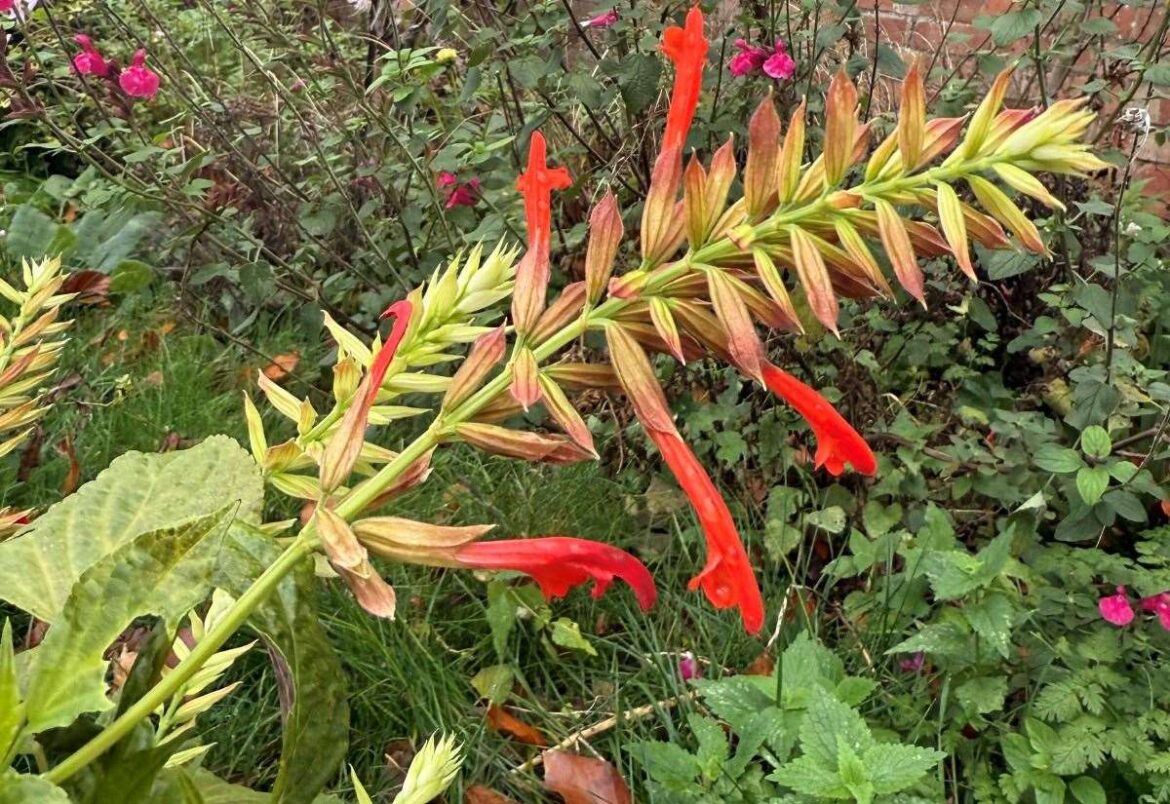In his weekly Jamie’s Little Allotment column, Gayton gardener Jamie Marsh explains how to ‘save bit of summer’ for next year…
Usually around the end of summer I take some cuttings from the plants that might not make it through a cold, wet winter. Salvias are always top of my list – they’re one of those plants I wouldn’t want to be without.
I’ve always loved them, the colours, the scent, and the way they keep flowering right up until the cold finally stops them.
Salvias are top of gardener Jamie’s list of plants he wouldn’t want to be without
This year I’m a bit later than usual. They were slow to start after the summer drought, but once the rain came they bounced back beautifully and are now looking fantastic. I don’t want to risk losing any if we get a hard or wet winter, so I’ve been out this week taking cuttings from several different varieties.
It’s a bit late in the season to be taking cuttings, but with a bit of warmth and light they should still root well. It’s a simple job and one that’s worth doing if you’ve got any tender plants you’d hate to lose.
Try to pick a fresh young stem that isn’t flowering and hasn’t turned woody. To be honest, this time of year it’s hard to find one without flowers, but if it does have them, just pinch them out. Cut the stem just below a leaf node at an angle – that’s the little joint where the leaves meet the stem.
Cuttings should still do well with a bit of warmth and light
It’s where the plant’s natural growth hormones are stored and those hormones send a signal to start growing roots once the cutting is in compost and kept warm.
Strip most of the leaves off and, if it’s a big-leafed variety, cut the remaining ones in half to stop too much water loss. I use seed compost in four-inch pots, pushing four or five cuttings round the edge of each pot. You can dip the ends into rooting powder if you want, but they’ll often root quite happily without it.
Because I’ve done mine later than usual, I’ve put them under lights and on a heat mat to keep them cosy. The gentle warmth tricks them into thinking it’s still summer and gets them rooting more quickly. With a bit of luck, they’ll be nicely established before winter really sets in.
Another thing you can start thinking about doing now is lifting the dahlias. When I was a child, I can remember helping my dad in the garden as he lifted them. Back then, it was just something everyone did. As soon as the first frost blackened the leaves, out they came.
Now is a good time to take cuttings from plants which might not survive the winter
Dad always said it was the only way to be sure they wouldn’t rot, because dahlia tubers don’t like the cold and they certainly don’t like being wet.
Times are changing though. With milder winters, more people are starting to leave their dahlias in the ground. It all depends on the soil. If your beds hold a lot of moisture, I’d still lift them, but if the ground drains well, you can leave them and pile a thick mound of mulch over the top to keep the frost off.
I leave most of mine in now, apart from one bed that always stays a bit wetter than the rest. That’s the one I lift every year. I cut the stems down, leaving a few inches above the soil, then get a fork right underneath the tuber and gently prise it out without spearing it.
Brush away the worst of the soil and turn them upside down in the shed or garage for a week or so to let any water drain out.
Once they’ve dried, clean them with a soft brush and get them ready for storing. Because we have horses, I’ve got plenty of wood shavings, but you can use anything that keeps them dry and insulated. Shredded paper, sawdust or even dried used compost all work fine.
I put the tubers in a large box, tucking them in snugly with plenty of shavings so they’re well protected from the cold. The key is to keep them warm, dry and frost free, so a shed or garage is ideal.
And don’t forget to label them. It’s amazing how similar they all look once the soil’s brushed away, and you’ll thank yourself next spring when you know exactly which one is which.
As the garden slows down, jobs like these feel like tucking everything in for winter. The salvias have new life waiting in their pots, the dahlias are safely stored away, and while most of the garden rests, there’s comfort in knowing a little bit of summer has been saved for next year.
If you have any questions email me at: Jamieslittleallotmentand@gmail


Comments are closed.